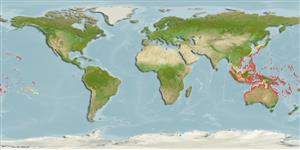Environment: milieu / climate zone / depth range / distribution range
Ökologie
seewasser riff-verbunden; tiefenbereich 0 - 60 m (Ref. 128797). Tropical; 37°N - 32°S, 95°E - 134°W
Pacific Ocean: widespread from Japan and Australia to the Tuamoto Islands and Hawaii. Replaced by Chaetodon trifasciatus in the Indian Ocean (Ref. 37816). DNA (from tissue samples) expected to further distinguished Chaetodon lunulatus and Chaetodon trifasciatus (Ref. 86689).
Length at first maturity / Size / Gewicht / Alter
Maturity: Lm ?, range 8 - 8.4 cm
Max length : 26.7 cm TL Männchen/unbestimmt; (Ref. 124696); max. veröff. Gewicht: 191.24 g (Ref. 124696); max. veröff. Alter: 12 Jahre (Ref. 56281)
Rückenflossenstacheln (insgesamt): 13 - 14; Rückenflossenweichstrahlen (insgesamt): 20-22; Afterflossenstacheln 3; Afterflossenweichstrahlen: 18 - 21.
Occur in monogamous pairs in coastal coral-rich areas (Ref. 47838, 48636). Juveniles hide among branches of small corals, often in lagoons (Ref. 9407). Benthopelagic (Ref. 58302). Feed solely on live corals (Ref. 47838). Oviparous (Ref. 205). Form pairs during breeding (Ref. 205).
Pairs form upon maturation for breeding purposes (Ref. 56281).
Allen, G.R., R. Steene and M. Allen, 1998. A guide to angelfishes and butterflyfishes. Odyssey Publishing/Tropical Reef Research. 250 p. (Ref. 47838)
IUCN Rote Liste Status (Ref. 130435)
Bedrohung für Menschen
Harmless
Nutzung durch Menschen
Mehr Information
ReferenzenAquakulturAquakultur ProfilZuchtlinienGenetikElectrophoresesVererbbarkeitKrankheitenVerarbeitungNutrientsMass conversion
Tools
Zusatzinformationen
Download XML
Internet Quellen
Estimates based on models
Preferred temperature (Ref.
123201): 24.7 - 29.3, mean 28.3 °C (based on 1779 cells).
Phylogenetic diversity index (Ref.
82804): PD
50 = 0.5000 [Uniqueness, from 0.5 = low to 2.0 = high].
Bayesian length-weight: a=0.02291 (0.01133 - 0.04632), b=3.00 (2.83 - 3.17), in cm total length, based on LWR estimates for this Genus-body shape (Ref.
93245).
Trophic level (Ref.
69278): 3.3 ±0.61 se; based on food items.
Widerstandsfähigkeit (Ref.
120179): hoch, Verdopplung der Population dauert weniger als 15 Monate. (Preliminary K or Fecundity.).
Fishing Vulnerability (Ref.
59153): Low vulnerability (17 of 100).
Nutrients (Ref.
124155): Calcium = 146 [71, 260] mg/100g; Iron = 1.15 [0.64, 2.07] mg/100g; Protein = 18.7 [17.4, 19.9] %; Omega3 = 0.117 [0.060, 0.229] g/100g; Selenium = 44.1 [20.5, 94.6] μg/100g; VitaminA = 30.4 [7.8, 118.9] μg/100g; Zinc = 1.79 [1.12, 2.78] mg/100g (wet weight);
